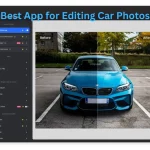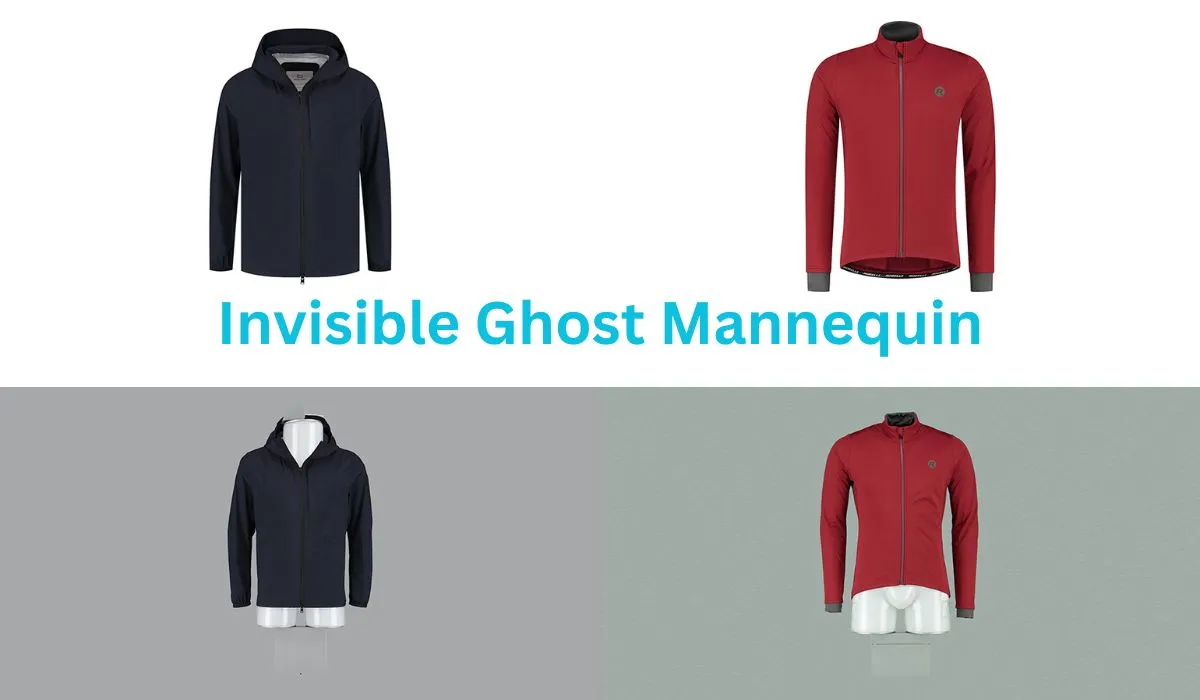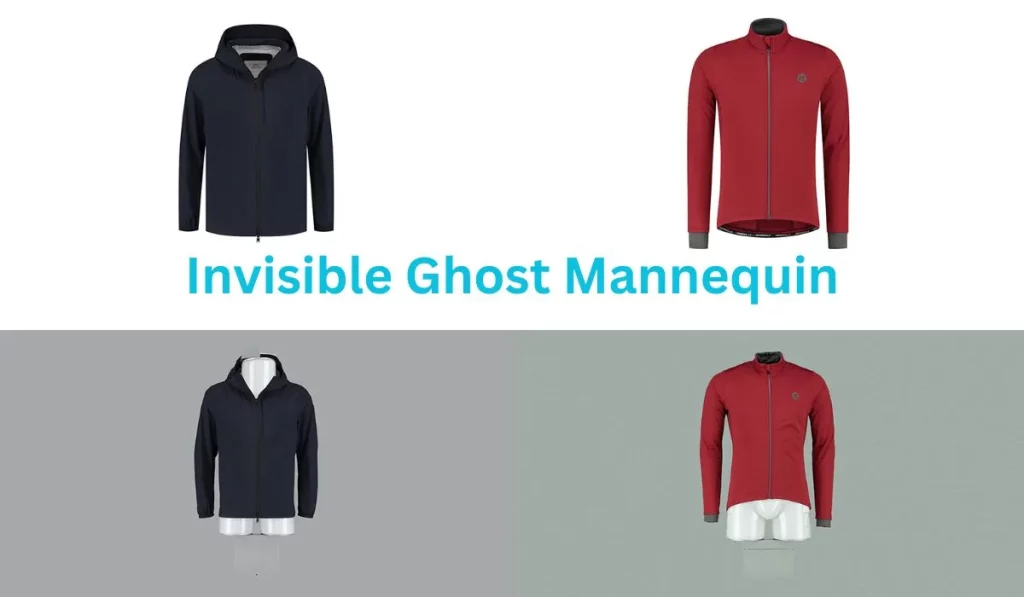Invisible ghost mannequin is one kind of photo editing technique that is used in the modern fashion industry. Almost all online fashion stores are using the invisible ghost mannequin technique to showcase their products. In this context, we share our experience about it.
Let’s jump into the deep:
What is an Invisible Ghost Mannequin
An invisible ghost mannequin, also known as a ghost mannequin or hollow mannequin, is a special photography and editing technique commonly used in the fashion industry to create images of clothing that appear to be worn by an invisible model. This technique is particularly useful for online and print catalogs, as it allows the clothing to be displayed in a way that showcases its shape, fit, and style without distractions.
It is especially popular for e-commerce websites and product catalogs because it allows customers to see how the clothing looks when worn without any distractions.
Importance of Ghost Mannequin in the Fashion Industry
Ghost mannequins play a significant role in the fashion industry for several important reasons. Here we share the importance of ghost mannequin in the fashion industry.
Visual Consistency:
Ghost mannequins help maintain a consistent and professional look in product images. By removing visible models or mannequins, the focus is solely on the clothing item, creating a unified visual style across a brand’s catalog or website.
Detail Showcase:
Ghost mannequin photography allows for a detailed presentation of clothing items. This is essential for customers who want to see the design, fit, and features of the garment, such as collar styles, zippers, buttons, and stitching.
3D Visualization:
When multiple images of the same garment are combined, the result can provide a 3D-like effect, offering customers a comprehensive view of the clothing from various angles, including the front, back, and sides. This enhances the online shopping experience.
Better Fit Assessment:
Shoppers can get a better understanding of how a particular garment will fit on their own bodies when they see it displayed on an invisible figure. This can reduce the likelihood of returns due to size and fit issues.
Distraction Elimination:
Ghost mannequins eliminate visual distractions that might occur when using live models or traditional mannequins, ensuring that the focus remains on the clothing itself. This can lead to more effective marketing and sales.
Cost Efficiency:
Using ghost mannequins can be more cost-effective than hiring models for every product shoot. It also saves time, as there’s no need to schedule and coordinate model sessions.
Increased Productivity:
Fashion brands can produce a large number of product images quickly and efficiently using ghost mannequins, which is essential for businesses with extensive catalogs and frequent product turnover.
Brand Image and Trust:
High-quality, consistent product images enhance a brand’s reputation and instill trust in customers. This can lead to increased customer loyalty and repeat business.
Versatility:
Ghost mannequins can be used for a wide range of clothing types, from dresses and shirts to outerwear and accessories. They are versatile tools for various fashion niches.
Global Accessibility:
Online retailers can reach a worldwide audience, and ghost mannequin images allow customers to assess clothing items without physically trying them on, making it easier for international customers to shop confidently.
In summary, the importance of ghost mannequins in the fashion industry lies in their ability to create high-quality, consistent, and detail-oriented product images that showcase clothing items effectively. These images help customers make informed purchase decisions, build brand trust, and streamline the process of presenting fashion products to a global audience.
Also Read:

The disadvantage of Invisible Ghost Mannequin
While invisible ghost mannequins offer numerous advantages for the fashion industry, there are some disadvantages and challenges associated with their use:
Cost and Expertise:
Implementing ghost mannequin photography and post-processing can be expensive, especially for small businesses that may not have the budget for professional photographers and graphic designers with expertise in this technique.
Time-Consuming:
The post-processing involved in creating ghost mannequin images can be time-consuming. Each image must be meticulously edited to remove the mannequin and blend different shots, which can slow down the product photography process.
Limited Pose Variation:
Ghost mannequins are typically limited to a single pose, which may not be suitable for all types of clothing or the desired artistic expression. Models can showcase different poses and attitudes, which is not possible with ghost mannequins.
Lack of Emotional Connection:
Unlike live models, ghost mannequins cannot convey emotions, personality, or lifestyle, which can be important for certain fashion brands aiming to connect with their audience on an emotional level.
Difficulty with Certain Materials:
Some fabrics, textures, and materials may not work well with ghost mannequins, as they may not hold their shape properly without a live model or a specially designed mannequin.
Need for Storage:
Maintaining and storing ghost mannequins can be challenging, especially for businesses with limited space. Traditional mannequins can often be disassembled or collapsed for storage, while ghost mannequins are usually bulkier.
Complex Clothing Items:
Very intricate or layered clothing items, such as wedding dresses or heavy winter coats, can be challenging to present effectively using ghost mannequins, as it may be difficult to maintain their shape and structure.
Adaptation to Various Body Types:
Ghost mannequins may not accurately represent the fit of clothing on different body types, and this can be a disadvantage for fashion brands that want to showcase their products’ versatility and inclusivity.
Overused Look:
As more fashion brands adopt ghost mannequin photography, there is a risk of creating a standardized look that lacks individuality, which may make it harder for a brand to stand out in a crowded market.
Customer Expectations:
In some cases, customers may prefer seeing clothing modeled on real people to get a better sense of how it will look on them. Ghost mannequins may not always satisfy these expectations.
It’s essential for fashion businesses to carefully consider these disadvantages and weigh them against the advantages when deciding whether to use ghost mannequins for their product photography. Some brands may choose to use a combination of ghost mannequins and live models to address these limitations.
How to Do Invisible Ghost Mannequin?
Creating invisible ghost mannequin photography involves a multi-step process, combining photography and post-production techniques. Here’s a basic overview of how to achieve this effect:
Materials and Equipment:
A mannequin specifically designed for ghost mannequin photography.
A camera with manual settings, preferably a DSLR or mirrorless camera.
A sturdy tripod to keep your camera stable.
Studio lighting equipment for even and controlled lighting.
A clean, well-lit studio space.
Photography editing software like Adobe Photoshop.
The Process:
Preparation:
Start by setting up your studio space and ensuring that the lighting is consistent and even. This helps create uniform and well-exposed images.
Dress the mannequin in the clothing item you want to photograph. Make sure it’s properly fitted and styled.
Camera Setup:
Place your camera on a tripod to maintain consistent framing.
Set your camera to manual mode to control exposure settings, including aperture, shutter speed, and ISO.
Use a narrow aperture (higher f-number) for a deeper depth of field to keep the entire clothing item in focus.
Set a low ISO for minimal noise in the images.
Focus the camera on the clothing, making sure it’s sharp and well-lit.
Photography:
Take multiple shots of the clothing item from different angles and perspectives, ensuring that each shot is properly exposed.
Capture shots of the front, back, sides, and any unique features of the garment. It’s essential to be consistent with the placement of the camera and lighting for all shots.
Post-Production:
Import your images into photo editing software (e.g., Adobe Photoshop).
Choose one image as the base shot, which will serve as the background for your invisible ghost mannequin effect.
For each of the other shots, you’ll need to carefully remove the mannequin from the frame. This typically involves using selection tools, such as the pen tool, to create a precise outline of the clothing.
Once you’ve removed the mannequin, place these isolated clothing pieces on top of the base image. Make sure they align perfectly to create the illusion of an invisible mannequin.
Blending and Adjustment:
Use layer masks and blending modes to seamlessly integrate the clothing pieces with the base image. You may need to adjust opacity and blending settings to ensure a natural transition.
Pay attention to fine details like shadows and highlights, and make adjustments to match the lighting and perspective.
Edit and retouch the image as needed, correcting any imperfections and enhancing colors and contrast.
Export and Save:
Once you are satisfied with the result, export the final image in the desired format and resolution for your use, such as for an e-commerce website or print catalog.
This process can be complex and may require advanced image editing skills. If you’re not comfortable with this level of post-production work, you can consider outsourcing the editing to professional graphic designers or photo editors who specialize in invisible ghost mannequin effects. Additionally, there are software tools and apps available that can automate parts of this process, though they may not provide the same level of customization and quality as manual editing.
End Words
Invisible ghost mannequin photography is a valuable tool for the fashion industry and is widely used by clothing brands and retailers to showcase their products effectively. It helps potential buyers get a clear understanding of how the clothing will look on them, leading to better-informed purchasing decisions.




